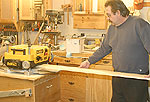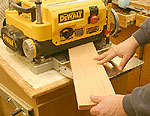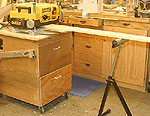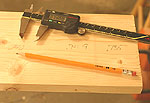This is a Veteran Owned site
 |
We only think we can hold a board perfectly level as it enters a planer. The result is usually snipe. Click image to enlarge |
Controlling Planer Snipe
A little support goes a long way
Text & Photos by Tom Hintz
Snipe is a short depression at the beginning or end of a board after passing through a planer. Usually snipe is shallow and only a few inches long, but it can be frustrating. What may be even more frustrating is that you may be causing at least some, if not all of the snipe.
Modern planers have snipe-fighting features such as headlocks and increased pressure applied by the feed rollers. Infeed and outfeed tables are also becoming popular as a way to combat snipe. All help, but operator error can still induce snipe.
The Cause
Snipe occurs when a board enters the cutting area of the planer with the leading or trailing end elevated. The length of the snipe usually corresponds to the distance between the feed rollers and the cutter head. If the board is not properly supported, it can tilt when it emerges from beneath one of the rollers that was holding it flat. Increased roller pressure can virtually eliminate snipe on relatively short boards but the weight generated by the leverage of longer pieces of wood is too much to handle.
 |
Sending relatively short boards through the planer at a steep angle helped because more of the table was supporting the wood. This is not the answer. Click image to enlarge |
One of the more popular "fixes" for snipe was to introduce the wood at a very steep horizontal angle. This actually worked if the board was short enough, but only because more of the wood was supported by the planer table because of the angle. As the length of the board gave leverage the advantage, this remedy failed as well.
The Fix
The good news is that most woodworkers already have the necessary equipment to drastically reduce, if not eliminate snipe. Adding a work support to the infeed and outfeed sides to keep the wood level as it passes through the planer is all it takes. Of course, the supports have to be set correctly to keep the wood level.
 |
Add a work support in front of and behind, adjusted to keep the wood level with the planer table and snipe is seldom an issue. Click image to enlarge |
Because the amount of tilt needed to induce snipe is so small, especially at the end of a long board, holding the wood level manually is wasted effort. Using a straightedge to align work supports with the table surface is easy and the real answer.
I have found that placing the work supports 24 to 36" from the end of the planer table, or extension tables, is sufficient. That placement increases the "flat" area considerably and allows me to keep the wood level as it enters the cutting area.
Spacing the work supports farther out is less effective because it releases the wood with enough length hanging off the tables to allow leverage to take over again. If very long boards are being planed, it may be necessary to have more than one work support to make this
 |
If the work support is too far from the planer, a subtle hump can occur as the wood flexes below the cutter head. Enlarge the photo and notice the different thicknesses. Click image to enlarge |
an easier task for a lone woodworker.
Setting up work supports may add a little time to the planning job but is well worth the effort. You save wood, frustration and perhaps the expense of buying a more expensive planer that will also cut snipe into your wood if you do not support it.
Need work supports? – Click Here
Have a comment on this story? – Email Me!
All written, photographic and drawn materials are property of and copyright by NewWoodworker.com LLC 2000-2019. Materials may not be used in any way without the written permission of the owner.


